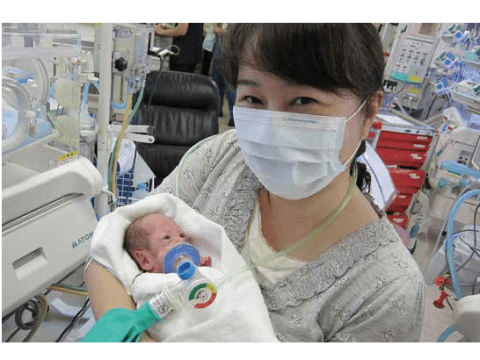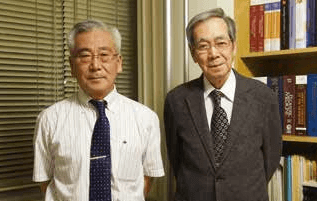Issue:

The country boasts the world’s highest survival rates of extremely premature babies thanks to advanced medicine – and the law. But it’s still a matter of contention.
When she first saw her new born son Kenta, Ayako Ishii did not feel a thing. There was no motherly love flooding her system, nor was she sad. She simply thought: “That isn’t a baby, it’s still a fetus.” Looking at the child’s narrow face, a typical feature of premature infants, she knew he should still be in her womb, not in an incubator. With only 23 weeks of gestation, he weighed just 500 grams, six times less than children born after a regular pregnancy of 39 weeks. But he had it good: the smallest preemie to ever survive in Japan only weighed 300 grams.
Many prematurely born children are physically and mentally handicapped to varying degrees. In fact, three years on, Kenta suffers from a light form of cerebral palsy as well as blindness, and his development is slowed. But at least he survived, even as it took his mother weeks to overcome her first shock. Her attitude only changed when a psychologist pointed out Kenta’s will to survive, manifested by his struggle to move his little arms and legs. Then, she says, she and her husband decided, “He’s making such an effort to live that we have to support him as much as we can.”
EVERY NINTH U.S. CHILD IS BORN BEFORE ITS TIME
The Ishiis are not alone. Though comparatively few children are born preterm in Japan less than six per 100 births preterm births of babies under 37 weeks of gestational age are on the rise worldwide. Even in developed countries like the U.S. every ninth child is born before its time. There are a number of theories about why this is happening. The fact that more and more women give birth for the first time later in life may be one reason; increased stress could be another. Infections of the birth canal may also lead to preterm births. Sometimes, as in the case of the Ishii family, the waters break too early and birth has to be induced. Often, however, the exact reasons remain a mystery.
No other country in the world saves as many extremely low birth weight children those who weigh less than 1000 grams and have spent only 22 or 23 weeks in the mother’s womb. Dr. Satoshi Kusuda from Tokyo’s Women’s Medical University, who was responsible for the care of little Kenta at the hospital’s neonatal intensive care unit (NICU), explains: “Children born after 22 weeks of gestation have a 50 percent chance of survival, and 50 percent of the survivors suffer physical damage, such as neurological defects. After 23 weeks of gestation, 80 percent of the children can be saved, 80 percent of them without suffering any handicap.”
In some countries doctors do not even try to save children born with just 22 weeks, but Japanese doctors are obliged to by law. According to most specialists, this is the utmost limit of viability. It’s also quite simple to remember, since women can have an abortion in Japan under certain conditions up to 21 weeks.
There are a number of reasons why Japan has so few preterm births and why it is so successful at saving them. One is that the country’s health system is well developed. It covers over a dozen health checks for the mother during pregnancy and all costs for the treatment of preemies. Such financial support can make it easier, especially for low income families, to decide whether doctors should save their child in critical cases or not. In other countries, the costs for some medications, which can make the difference between life and death, have to be shouldered by the parents themselves.
Another factor that impacts the survival rate is the highly specialized equipment available. In the 1970s, there were no respirators for extremely small babies in Japan. Children born weighing less than 1500 grams were considered nonviable back then. But now Japan ranks high among nations with the highest standards of equipment and training. In Tokyo, for example, a system linking 25 hospitals that can take care of preemies and their mothers has been in operation for over 10 years: participants are able to check in real time the availability of spare hospital beds at clinics specializing in neonatology. In addition, the condition of every child at Dr. Kusuda’s unit is monitored and recorded by a personal computer placed next to its incubator.
Another unique feature of the Japanese system is that every NICU employs specialists who have the authority and knowledge to conduct all necessary checks and treatments themselves, on site. At least one of these “almighty” doctors is present at all times, and each is capable of determining the whole treatment strategy, according to Kusuda. That is different from the U.S. system, for example, where the division of labor is more prevalent and the infants have to be taken to different rooms for different examinations.
For Hiroshi Nishida, one of Japan’s leading neonatologists, the doctors’ attitude towards their tiny patients is another decisive factor. “Even at the very beginning of their lives, preemies are human beings,” he says. “Therefore we do every thing we can to help them survive. That is how we achieve our high survival rate.” In the early days of Japanese pree mie medicine, Nishida devised ethical standards for doctors they could refer to when deciding whether or not to continue treatment and to what degree.
Kusuda says that doctors try to treat their small patients as non invasively as possible when giving injections, drawing blood samples or conducting ultrasound tests. They provide the infants with food, give them oxygen and keep them warm. “We try to create an environment similar to the one in the mother’s womb,” he says. “Then we observe how the child develops.”
THE PROS AND CONS OF SAVING EARLY LIVES
If Kenta had been born in China, he might not have lived to become a three yearold who loves to listen to music and play with his parents. There, doctors only save preemies born with 28 weeks of gestation a full six weeks later than in Japan. At least in major cities like Shanghai, where neonatology clinics are on par with Japan, this is not due to a lack of knowledge or technology. It is the cost involved, not only for the infant in question and his family, but also for society as a whole: preemie care is extremely expensive and its outcome often hard to predict. Financial and other resources put into their treatment become unavailable for other research and treatment. And this view is not only limited to China. Similar reasons are put forth in the U.S. and some European countries. Ethical considerations and the psychological impact on the child’s parents are also very important factors in the decision making process. In Europe, most doctors start to actively support preemies in their struggle for survival from between 23 and 26 weeks of gestation.
The situation in Japan changed after a couple of cases in which children survived with only 22 weeks of gestation, and since 1990, Japanese doctors have been obliged by law to save preterm babies from 22 weeks. Neonatologist Nishida was involved in the drafting of the law, and for him, the argument that a child might be born disabled does not count. “We should not engage in social Darwinism,” he says. “All life is equal.”
No other country in the world saves as many extremely low-birth-weight children
In spite of the law, the limit of viability is still a matter of dispute among Japanese neonatologists. Some, citing the peculiarities of each child’s condition, question if the length of gestation was calculated properly when the law was pushed through. Dr. Fujiwara, the discoverer of surfactant (see box, right), considers 24 weeks the lowest limit and would even prefer to see it raised to 26 weeks. “The younger the children, the higher the mortality rates,” he explains. The 84 year old still treats patients, and encourages his younger colleagues as well as obstetricians to engage more in proactive, clinical research, including animal experiments. This research, he argues, should not exclusively focus on preemies but on expectant mothers as well. The most important focus in his view should be on “preventing premature births in the first place.”
Sonja Blaschke is a German freelance journalist writing for publications in Germany, Austria and Switzerland. She also works as a producer for TV filming in Japan.
HOW CALVES’ LUNGS (AND DR. TETSURO FUJIWARA) SAVED THOUSANDS OF YOUNG LIVES

PATRICK, THE FIVE AND A HALF WEEK prematurely born son of U.S. President John F. Kennedy, was in trouble from the start, after being delivered by Caesarean section on Aug. 7, 1963. He could breathe in, but not out, and less than two days later he was to die of respiratory distress syndrome, or RDS. One of the biggest challenges for premature births other than brain damage and heart problems had always been under developed lungs. In fact, only 30 years ago, half of such babies died of suffocation. While doctors had known since the 1950s that preemies lacked a substance called “surfactant,” a coating for the lungs that helps the pulmonary alveoli to maintain the surface tension necessary for breathing, the search for a cure had stalled after several setbacks.
The high profile death of young Patrick gave a much needed push to further research, and a call from his former mentor at UCLA encouraged a young pediatrist at Akita University to delve deeper into the issue. Tetsuro Fujiwara had his own motivation as well: as a young doctor he had been unable to save a child who died from RDS.
It was a visit to a slaughterhouse that would hold the key. Fujiwara asked for the lungs of recently born lambs and calves to study in his research. After mincing them and putting them in a centrifuge he found a whitish liquid in the mix. It turned out to be surfactant, and after extensive testing, Fujiwara had developed the substance to a level suitable for human tests.
The first opportunity came when a schoolteacher who had lost six children from miscarriages gave birth to a child who suffered from RDS. She pleaded with Fujiwara for help. After testing it on himself, Fujiwara injected the surfactant into the child’s lungs. The child survived, and Fujiwara’s report on his successful surfactant research was published to much attention in the medical journal The Lancet in January 1980. In the years since, thousands of children around the world have been saved by his surfactant replacement therapy. In 1996 Fujiwara, along with Swedish scientist Bengt Robertson, another pioneer in surfactant research, was awarded the prestigious King Faisal International Prize. Fujiwara now lives and works in Morioka, Iwate Prefecture.

